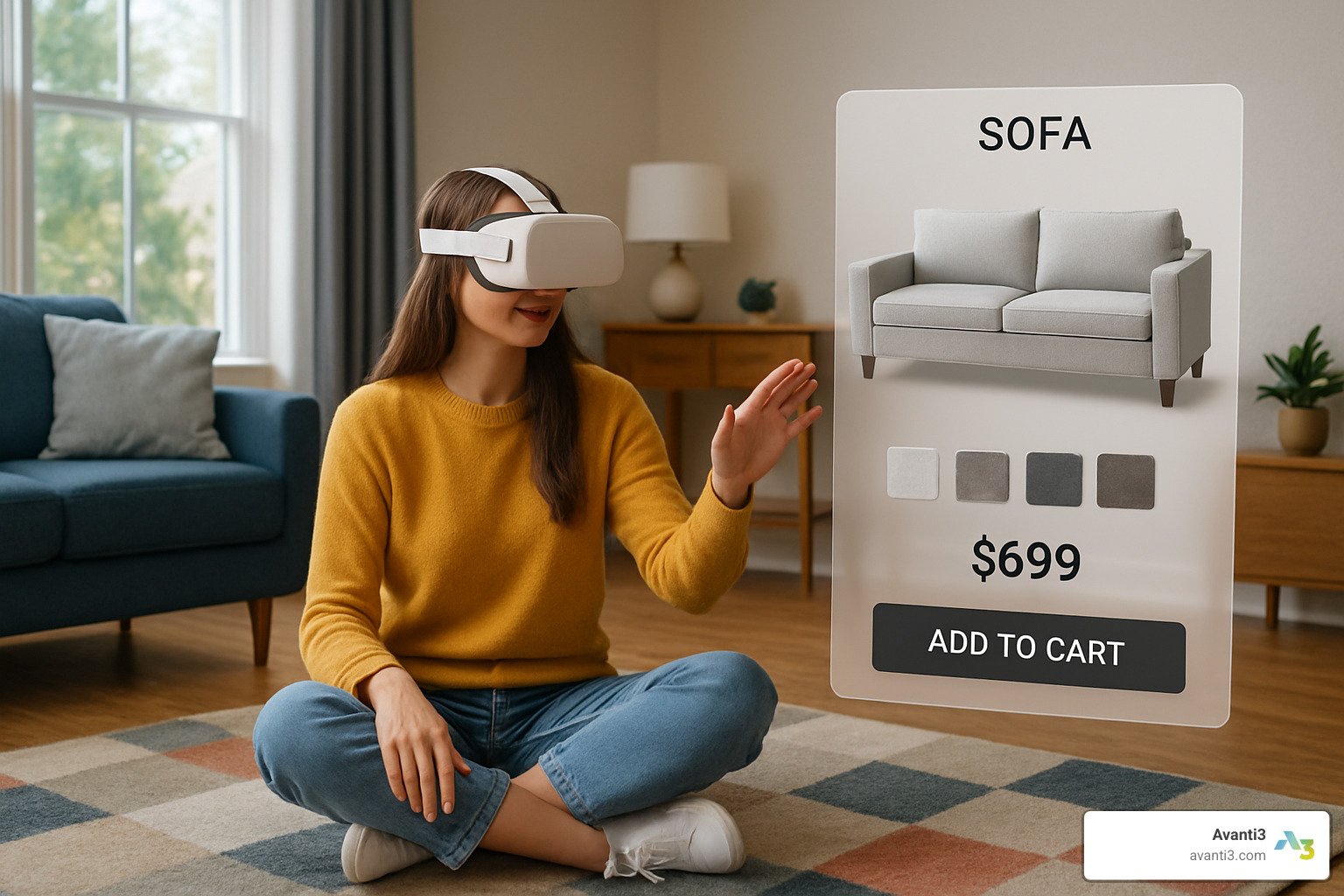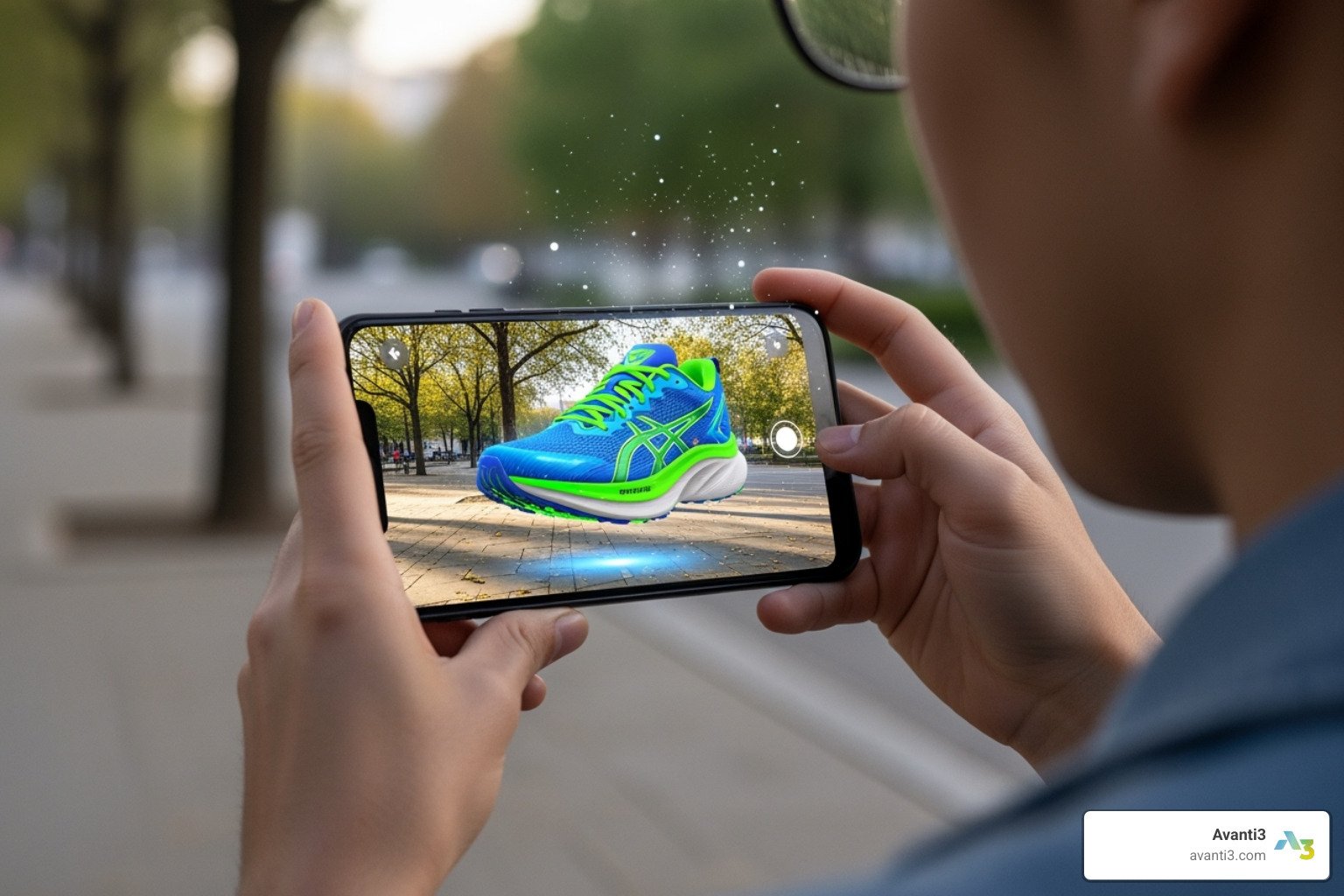Ar VR Shopping: 10 Powerful Trends Revolutionizing 2025
Why AR VR Shopping Is Changing How We Buy
AR VR shopping is revolutionizing retail by blending digital experiences with physical products. Instead of guessing how something looks or fits, shoppers can now virtually try on clothes, place furniture in their homes, or walk through digital stores—all before making a purchase.
Quick Definition:
– AR Shopping: Overlays digital products onto your real environment using your phone or tablet
– VR Shopping: Creates fully immersive virtual stores you explore with headsets
– Combined Impact: 112% higher conversion rates and 30% fewer returns for retailers
The numbers tell the story. Global social commerce is exploding from $492 billion in 2021 to a projected $1.2 trillion by 2025. Gen Z and Millennials will drive 62% of this growth, with 27% already interested in AR/VR store experiences.
The shift is clear: shopping is becoming immersive. Half of US adults have either used or want to try AR/VR while shopping. Virtual try-ons boost sales by 20% while cutting returns by 30%.
I’m Samir ElKamouny AV, and I’ve helped countless businesses transform their customer engagement through innovative marketing strategies, including AR VR shopping implementations that drive real results.
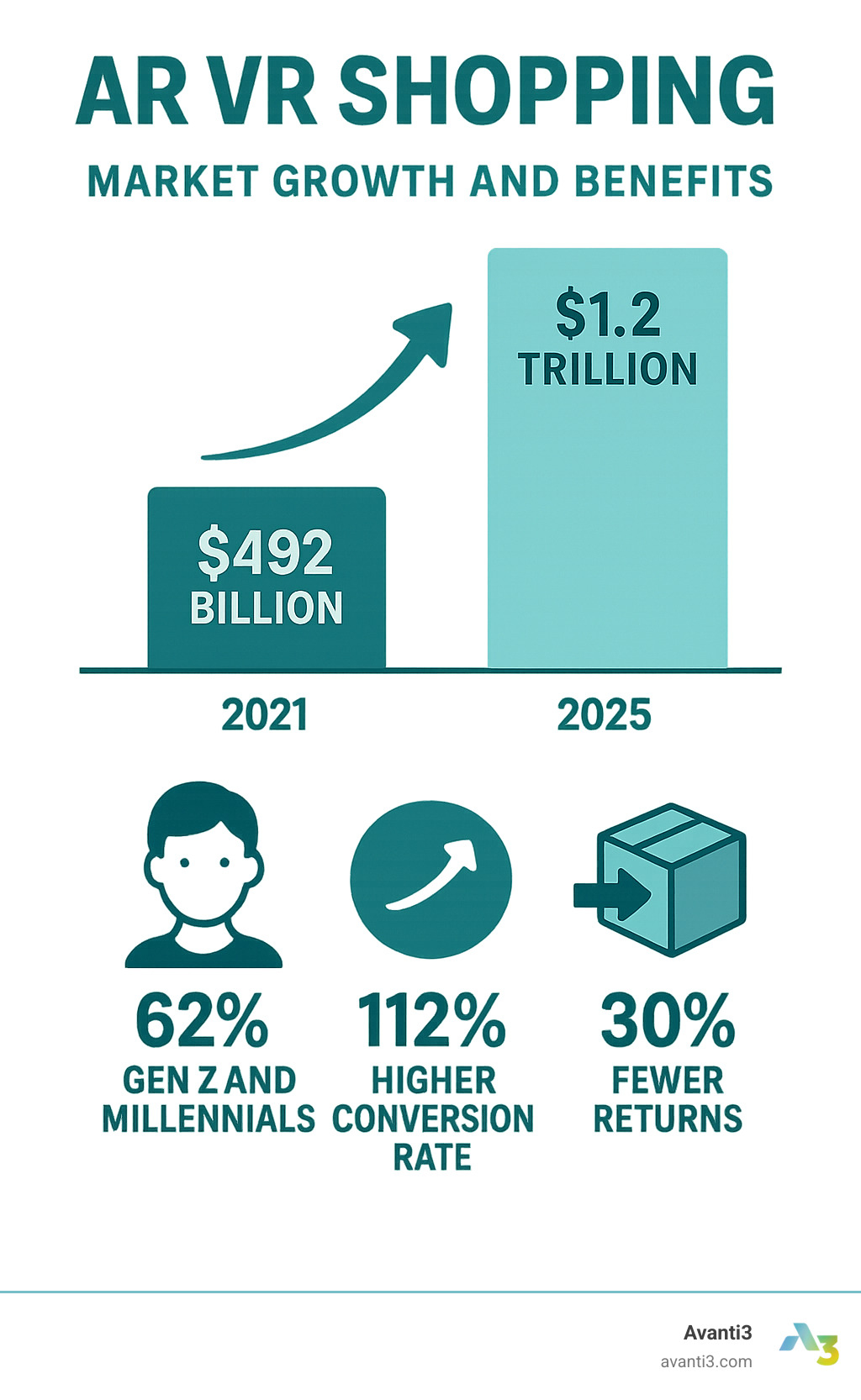
What Is AR vs VR Shopping? – Core Concepts of AR VR Shopping
Augmented Reality (AR) Shopping works like a digital overlay on your real world. When you hold up your phone to see how that new couch would look in your living room, you’re using AR. The technology takes what you’re already seeing and adds virtual elements to it.
The beauty of AR shopping is its simplicity. You probably already have everything you need—your smartphone or tablet. No fancy equipment, no complicated setup. Just point, tap, and suddenly you’re trying on sunglasses or testing paint colors on your walls.
Virtual Reality (VR) Shopping takes a completely different approach. Put on a VR headset, and you’re transported somewhere entirely new. You might find yourself walking through a virtual Nike store, picking up shoes, or exploring a digital mall with friends from across the country.
Extended Reality (XR) is simply the umbrella term that covers both AR and VR, plus mixed reality experiences that blend the two.
WebAR runs directly in your web browser—no app downloads, no waiting. App-based AR requires downloading specific applications, but offers richer, more detailed experiences.
| Feature | AR Shopping | VR Shopping |
|---|---|---|
| Device Needed | Smartphone/Tablet | VR Headset ($200+) |
| Environment | Real world improved | Fully virtual |
| Accessibility | High (most people have phones) | Lower (requires headset) |
| Use Cases | Try-ons, furniture placement | Virtual stores, immersive demos |
| Friction | Low (WebAR) to Medium (apps) | High (equipment setup) |
Key Technical Building Blocks
3D modeling creates incredibly realistic digital versions of products you see. Every wrinkle in a shirt, every reflection on a watch face—it all needs to be perfect. AI is now helping create these 3D models automatically.
Computer vision makes your device smart enough to understand what it’s looking at. When you’re trying on virtual lipstick and the app knows exactly where your lips are, that’s computer vision doing its magic.
Spatial mapping helps AR figure out your physical space. It measures your room, identifies your coffee table, and makes sure that virtual armchair appears the right size and sits properly on your floor.
Haptic feedback adds the sense of touch to VR experiences. Some cutting-edge VR shopping platforms use special gloves that let you actually “feel” the texture of a sweater.
AR VR Shopping Across the Customer Journey
AR VR shopping transforms every step of your shopping journey into something more engaging and helpful.
During the awareness stage, you might find interactive AR ads on social media that let you try on sneakers right from your feed. In the consideration stage, virtual try-ons become your new best friend—no more wondering if those glasses will look good on you.
When you reach the purchase stage, immersive product demonstrations seal the deal. Even after you buy, AR VR shopping keeps helping with AR assembly instructions and VR customer service.
How AR & VR Are Changing Retail and E-commerce
The impact of AR VR shopping on retail goes far beyond novelty. We’re seeing fundamental shifts in how consumers find, evaluate, and purchase products.
The statistics are compelling: AR users show 112% higher conversion rates compared to traditional shoppers. They also demonstrate two-fold increases in average order values. Perhaps most importantly for retailers, brands offering virtual try-ons see 30% drops in return rates—a massive cost savings.
These technologies enable true omnichannel experiences. Customers might find a product through AR on social media, try it virtually at home, then purchase seamlessly within the same app. The boundaries between online and offline shopping are dissolving.
Personalization reaches new heights with AR VR shopping. AI-powered virtual assistants can suggest products based on your virtual try-on history, body measurements, and style preferences.
Augmented Reality Marketing has become a crucial strategy for brands looking to stand out in crowded digital spaces.
Benefits for Shoppers
AR VR shopping solves many traditional e-commerce pain points:
Increased Confidence: Seeing how products look in your actual environment eliminates guesswork. No more wondering if that couch will fit or if those shoes match your style.
Convenience: Try on dozens of outfits without leaving home. Test furniture arrangements without heavy lifting. Shop during off-hours when physical stores are closed.
Reduced Friction: WebAR experiences require no app downloads. Point, click, and try—it’s that simple.
Accessibility: Virtual shopping breaks down geographical barriers. Rural customers access the same experiences as urban shoppers.
Retailer Advantages
For retailers, AR VR shopping delivers measurable business benefits:
Higher Average Order Values: When customers can confidently visualize products, they’re willing to spend more. Research shows 40% of shoppers will pay premium prices for AR-tested products.
Rich Data Insights: AR interactions provide unprecedented data about customer preferences, body measurements, and shopping behaviors.
Reduced Return Logistics: The 30% reduction in returns translates to significant cost savings in shipping, restocking, and customer service.
Global Reach: Virtual storefronts operate 24/7 without geographical limitations.
Measuring ROI in AR VR Shopping
Smart retailers track specific KPIs to measure AR VR shopping success:
Dwell Time: How long customers engage with AR/VR experiences indicates interest and intent.
Conversion Rate Delta: The percentage improvement in conversions between AR/VR users and traditional shoppers.
Return Rate Reduction: The decrease in product returns from customers who used virtual try-on features.
Basket Size Increase: The growth in average order values from immersive shopping experiences.
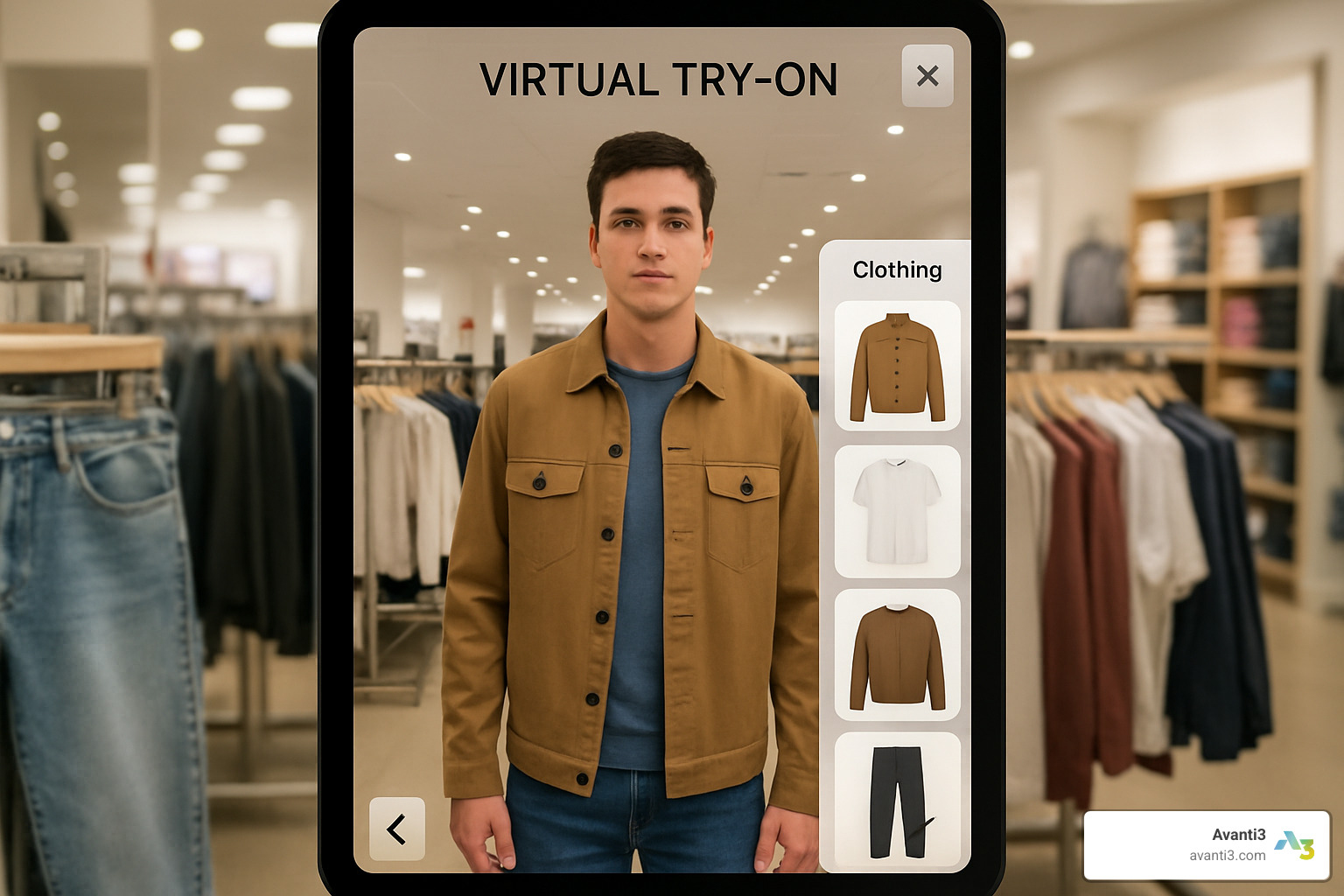
Real-World Success Stories & Use Cases
The most compelling evidence for AR VR shopping comes from brands already seeing results. Let’s explore how leading retailers are implementing these technologies.
Virtual Try-Ons have become the gold standard for fashion and beauty retailers. Customers can test clothing, accessories, makeup, and eyewear without physical contact. German eyewear retailers have developed AR systems that digitally remove existing glasses to show clear virtual fittings.
Furniture Placement allows customers to visualize home goods in their actual spaces. Instead of measuring and imagining, shoppers see exactly how items will look and fit.
Virtual Malls create fully immersive shopping environments. Customers can walk through digital stores, browse products, and interact with virtual sales assistants—all from their living rooms.
Pop-Up Events in VR enable brands to create exclusive, limited-time experiences. Fashion brands host virtual runway shows, while tech companies demonstrate products in impossible virtual environments.
Case Study Highlights
IKEA’s Place App revolutionized furniture shopping by letting customers place 3D models in their homes. The app uses advanced AR to ensure accurate scaling and realistic lighting, helping customers make confident purchase decisions.
Nike’s Snapchat Lens allows users to customize Air Force 1 sneakers with 13 different color and texture options. The AR experience creates shareable content while driving product awareness and sales.
Sephora’s Virtual Artist uses AR to let customers try on makeup virtually. The technology maps facial features in real-time, applying cosmetics with realistic lighting and blending.
Best Buy’s Vision Pro App enables customers to visualize electronics in their homes before purchasing. The AR experience helps customers understand product sizes and placement options.
Research from an October 2021 survey showed that social media AR shopping experiences drive significant engagement and conversion improvements.
Industry-Specific Applications
Fashion: Virtual fitting rooms reduce return rates while increasing customer satisfaction. Brands can showcase entire collections without physical inventory limitations.
Beauty: AR makeup try-ons eliminate hygiene concerns while enabling customers to experiment with bold looks they might not try in-store.
Home Décor: Furniture and decor visualization helps customers make confident decisions about expensive purchases that are difficult to return.
Automotive: VR showrooms let customers explore vehicle interiors, test configurations, and experience driving simulations when physical test drives aren’t possible.
Grocery: AR navigation helps customers find products in large stores, while virtual shopping assistants provide recipe suggestions and nutritional information.
Challenges, Costs & Getting Started
Implementing AR VR shopping isn’t as simple as flipping a switch. While the potential rewards are massive, retailers face real challenges that need thoughtful planning to overcome.
Hardware expenses create the first barrier. AR shopping works great because most people already carry smartphones, but VR tells a different story. Quality VR headsets start around $200 and can cost much more for premium experiences.
The 3D asset creation challenge often catches retailers off guard. Every product needs a digital twin—a perfect 3D model with accurate textures, realistic lighting, and proper physics. Creating these assets requires specialized artists and significant time investment.
Integration problems emerge when connecting new AR experiences with existing systems. Your virtual try-on tool needs to talk to inventory management, payment processing, and customer databases.
Consumer adoption varies dramatically across different groups. Gen Z customers dive into AR filters without hesitation, but convincing older shoppers takes patience and education.
Privacy and data security concerns intensify with immersive technologies. AR VR shopping collects biometric data, spatial information about homes, and detailed behavioral patterns.
Here’s the good news: WebAR offers a frictionless solution that sidesteps many adoption barriers. Customers access AR experiences directly through web browsers—no app downloads, no account creation, no friction.
AR VR Immersive Experiences require careful planning, but the payoff justifies the effort when executed thoughtfully.
Budget & Resource Planning for AR VR Shopping
Smart retailers approach AR VR shopping budgets strategically, balancing ambition with reality.
SaaS platforms provide the most accessible entry point for smaller retailers. Monthly subscription fees typically range from hundreds to thousands of dollars, depending on features and product volume.
Custom builds offer maximum flexibility but demand serious investment. Development costs can range from tens of thousands for basic experiences to millions for sophisticated implementations.
The pilot versus scale decision shapes your entire budget approach. Wise retailers start with focused pilot programs targeting specific product categories or customer segments.
Staffing needs include 3D artists, AR/VR developers, UX designers, and project managers. Many retailers find that partnering with specialized agencies provides faster access to these skills.
Implementation Roadmap
Success with AR VR shopping follows a predictable pattern when approached systematically.
Define your use case by identifying specific customer pain points that immersive technology can solve. Focus on high-impact scenarios like reducing return rates for furniture or increasing confidence in online clothing purchases.
Prototype development starts with minimum viable experiences that test core concepts. A simple AR try-on for a few bestselling products teaches more than months of planning.
User testing with real customers reveals gaps between your assumptions and reality. Watch how people actually interact with your AR experience—the results often surprise even experienced retailers.
Deploy gradually with limited product sets or customer segments. Launch virtual try-ons for your most popular items first, then expand based on performance data.
Iterate continuously because AR VR shopping experiences require ongoing refinement. Technology evolves rapidly, customer expectations shift, and new opportunities emerge.
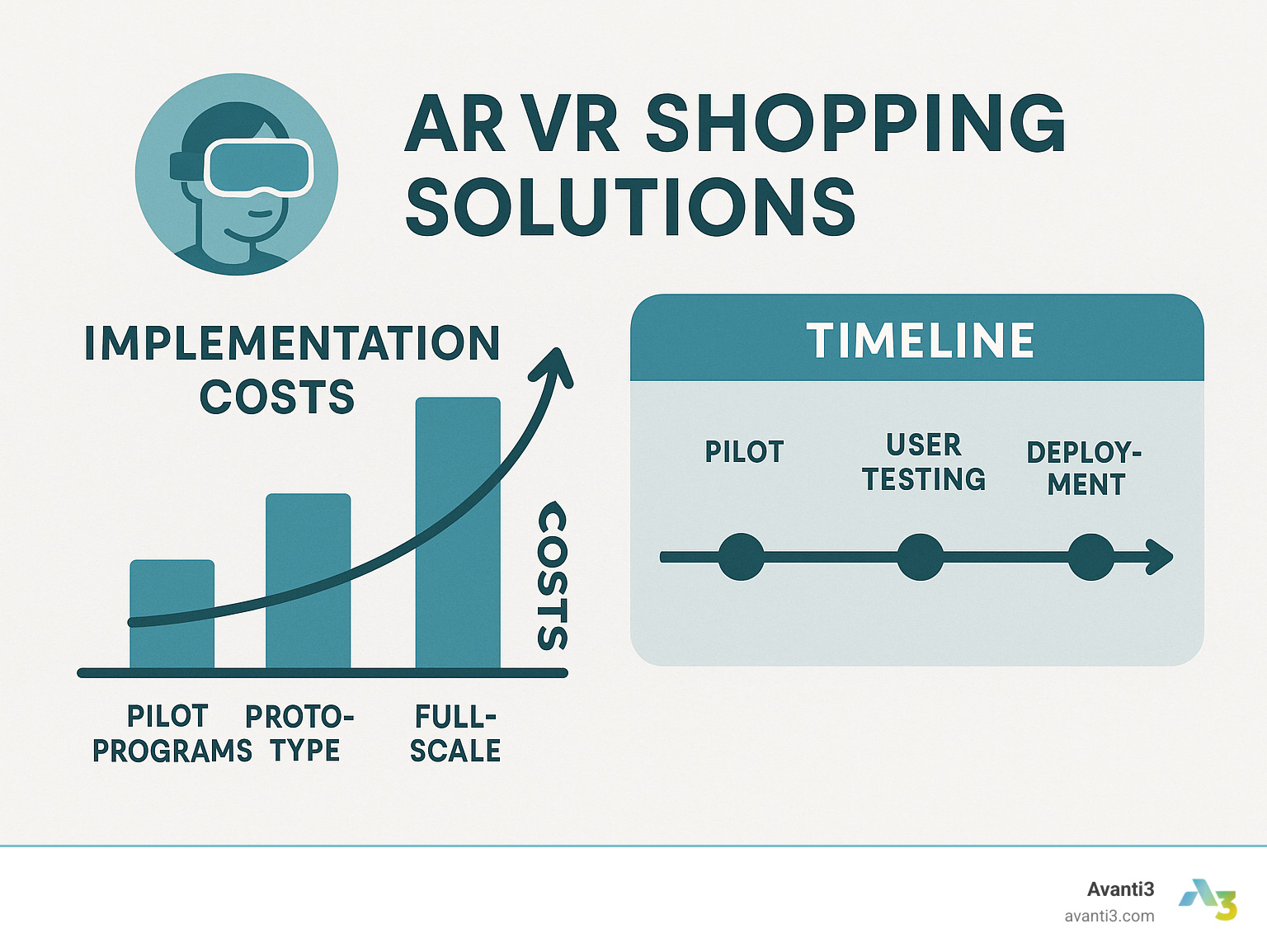
Future Trends & Innovations
The future of AR VR shopping is arriving faster than most people expect. We’re standing at the edge of a shopping revolution that will make today’s experiences look primitive.
Wearable AR glasses represent the biggest game-changer coming our way. Imagine walking through a store and instantly seeing product reviews, price comparisons, and personalization suggestions floating right in your field of vision. As these glasses become lighter and cheaper, AR VR shopping will feel as natural as looking around.
The technology behind mixed reality is getting seriously impressive. Instead of choosing between AR or VR, you’ll get both at once. Picture trying on clothes virtually while still seeing your real bedroom, then instantly switching to a virtual boutique to browse accessories.
Virtual malls are evolving into something much cooler than digital storefronts. Soon you’ll shop with friends from across the globe as if you’re all in the same place. Your avatar and your best friend’s avatar can walk through stores together, sharing opinions and making decisions in real-time.
The speed of innovation is accelerating thanks to AI-generated 3D models. What used to take weeks of painstaking work now happens in hours. Brands can launch virtual try-on experiences for new products almost instantly.
Blockchain loyalty programs are creating rewards that actually travel with you across different stores and platforms. Sustainability features will help you make better choices by showing the real environmental impact of your purchases before you buy.
Learn more about how emerging XR platforms are shaping the future of retail.
Convergence of AR, VR, AI & Web3
The most exciting developments happen when AR VR shopping meets other cutting-edge technologies.
Tokenized rewards turn shopping into something closer to gaming. Every purchase, review, or social share earns you cryptocurrency or digital collectibles. These rewards have real value and can be traded or used across multiple platforms.
NFT integration opens up entirely new product categories. You might buy a digital outfit for your avatar that works in virtual stores, social media, and gaming platforms. Physical and digital goods start blending together in ways that create more value for customers.
Predictive commerce powered by AI becomes almost magical. The system learns your preferences so well that it suggests products before you even realize you need them.
Edge computing makes everything feel instant and natural. No more waiting for virtual try-ons to load or dealing with laggy AR experiences.
Regional & Generational Adoption Patterns
The adoption of AR VR shopping varies dramatically depending on where you live and how old you are.
China vs US markets show fascinating contrasts. Chinese consumers accept mobile payments and social commerce much more readily, creating perfect conditions for AR shopping integration.
Gen Alpha expectations will drive the next wave of innovation. Kids who grew up with AR filters and VR games won’t just want immersive shopping—they’ll demand it. These digital natives will expect every product to be tryable, every store to be visitable virtually, and every purchase to include digital elements.
The mobile-first vs headset-first debate reflects different economic realities around the world. Developing markets might skip traditional VR headsets entirely, jumping straight to smartphone-based AR experiences.
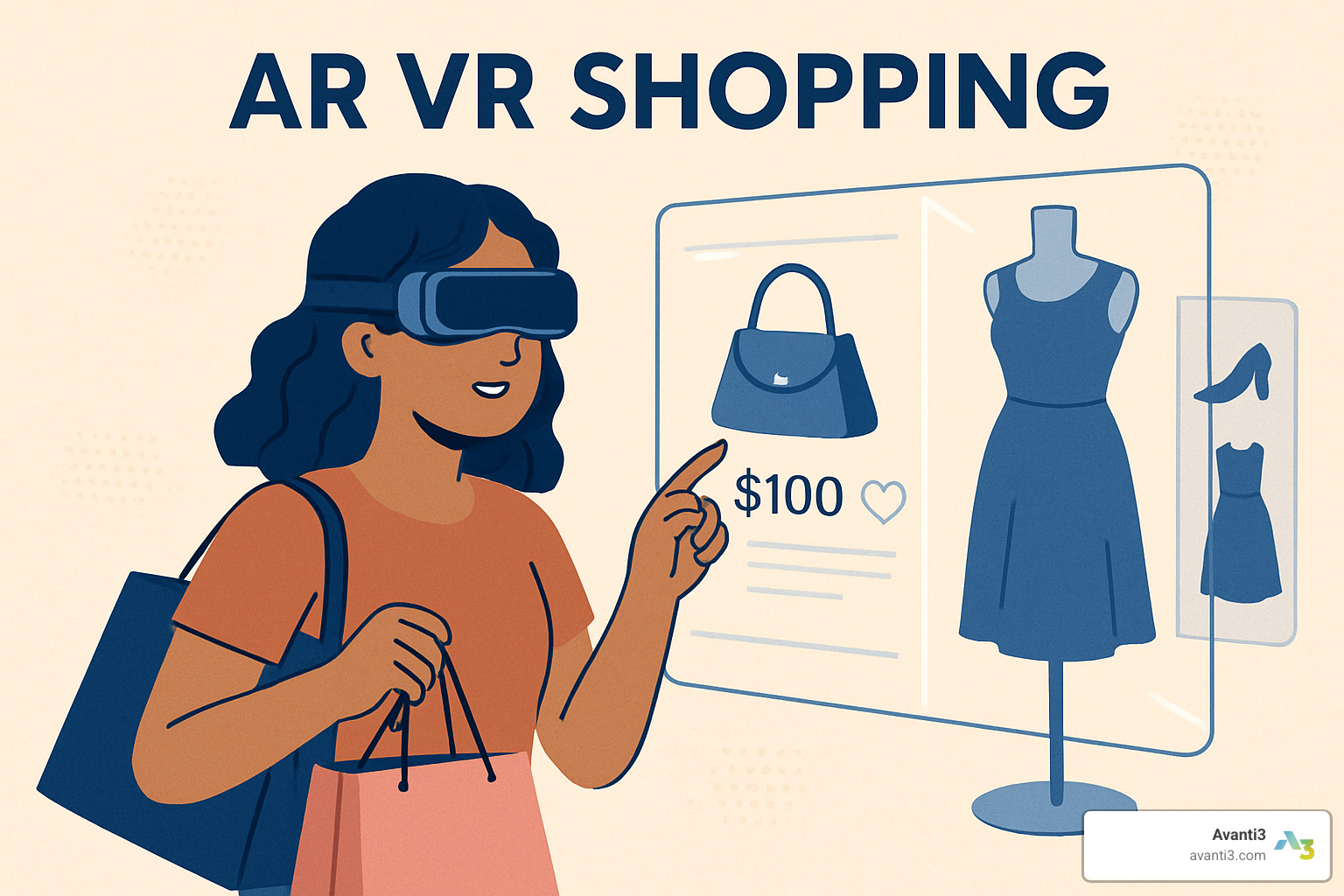
Frequently Asked Questions about AR VR Shopping
Let’s tackle the most common questions I hear from retailers and shoppers about AR VR shopping. These answers come from real-world data and practical experience helping businesses implement these technologies.
How do AR and VR impact conversion rates and returns?
The numbers don’t lie—AR VR shopping creates dramatic improvements in the metrics that matter most to retailers. When customers can virtually try on products or see them in their own space, they buy more and return less.
Here’s what the data shows: AR users convert at 112% higher rates than traditional online shoppers. That’s more than double the success rate. Even better, these customers spend more per order, with average order values increasing by two-fold.
But here’s the real game-changer—return rates drop by 30% when customers use virtual try-on features. If you’re a retailer with $10 million in annual sales, that 30% reduction could save you hundreds of thousands in shipping, restocking, and customer service costs.
Why does this happen? Simple. When customers can see exactly how that couch looks in their living room or how those glasses fit their face, they make smarter purchase decisions. No more guessing, no more buyer’s remorse.
Customers who use AR features report feeling 40% more confident about their purchases. That confidence translates directly into sales and fewer returns.
What privacy and data safeguards are required?
AR VR shopping technologies collect some pretty sensitive information—facial mapping for virtual try-ons, room layouts for furniture placement, and detailed behavioral data about how you shop. That’s why privacy protection isn’t just important, it’s essential.
Smart retailers follow the data minimization principle: collect only what you absolutely need for the AR/VR experience to work. If you’re offering virtual makeup try-on, you need facial mapping data. But you don’t need to store that information after the session ends.
Transparency builds trust. Your customers should know exactly what data you’re collecting, why you need it, and how long you’ll keep it. No hidden surprises, no confusing legal jargon.
Secure storage means using encryption and protected servers. Customer data should be locked down tighter than your most valuable inventory.
Give customers control over their data. They should be able to delete their information, opt out of certain features, or limit data collection. When people feel in control, they’re more likely to engage with your AR/VR experiences.
Compliance matters. GDPR, CCPA, and emerging biometric privacy laws all apply to AR/VR data. Work with legal experts to ensure you’re meeting all requirements in every market where you operate.
How can small retailers afford AR VR shopping solutions?
Here’s the good news—you don’t need a massive budget to get started with AR VR shopping. The technology has become much more accessible, with options for every business size.
SaaS platforms offer the most affordable entry point. For $50 to $500 per month, you can access professional AR features without huge upfront investments. These platforms handle the technical complexity while you focus on creating great customer experiences.
Social media AR costs almost nothing to start. Platforms like Snapchat and Instagram provide free tools for creating simple try-on experiences. Your customers are already using these platforms, so you’re meeting them where they are.
WebAR solutions eliminate app development costs entirely. Customers access AR experiences directly through their web browsers—no downloads, no friction, no extra development expenses.
Start with a pilot program focusing on your best-selling products or biggest customer pain points. Maybe it’s virtual try-ons for your top 10 eyewear styles, or AR furniture placement for your most popular items. Prove the concept works before expanding.
Some technology providers offer revenue-sharing models instead of upfront fees. You pay based on the sales generated through AR experiences, aligning costs with results.
The key is thinking strategically. You don’t need to transform your entire catalog overnight. Start small, measure results, and scale what works.
Conclusion
The change is happening right now. AR VR shopping isn’t some distant future concept—it’s reshaping how people find, try, and buy products today. We’re witnessing the birth of truly omnichannel retail, where the line between digital and physical shopping fades away completely.
The numbers don’t lie. When 71% of consumers expect personalized interactions and 40% will gladly pay premium prices for AR-tested products, retailers face a clear choice. They can accept immersive shopping experiences now, or watch competitors capture increasingly tech-savvy customers.
Success isn’t about having the flashiest technology. It’s about solving real problems for real people. The retailers winning with AR VR shopping focus on reducing customer uncertainty, making shopping more convenient, and creating experiences that genuinely delight their audiences.
Think about it: when someone can virtually try on dozens of outfits without leaving their couch, or see exactly how that new couch looks in their living room, shopping becomes fun again. It stops being a gamble and starts being an trip.
The future holds even more exciting possibilities. As AR, VR, AI, and Web3 technologies continue merging, we’ll see shopping experiences that feel almost magical. Imagine walking through virtual stores with friends from around the world, earning digital rewards that work across multiple brands, or having AI assistants that know your style better than you do.
Smart retailers are already experimenting with these technologies. They’re learning what works, what doesn’t, and how to create experiences that truly matter to their customers. When the next wave of innovation hits, they’ll be ready to ride it.
At Avanti3, we empower brands with turnkey XR engagement solutions that create meaningful connections between companies and their customers. Our platform combines immersive experiences with blockchain rewards and AI-driven personalization—all designed to deliver results that actually move the needle for your business.
The future of retail is immersive, personal, and incredibly exciting. By embracing AR VR shopping today, you’re not just keeping up with trends—you’re preparing for a world where amazing customer experiences become the baseline expectation.
Virtual Reality Experiences represent just the beginning of what becomes possible when cutting-edge technology meets genuine customer understanding. The question isn’t whether this future will arrive—it’s whether you’ll be leading the charge or playing catch-up.

